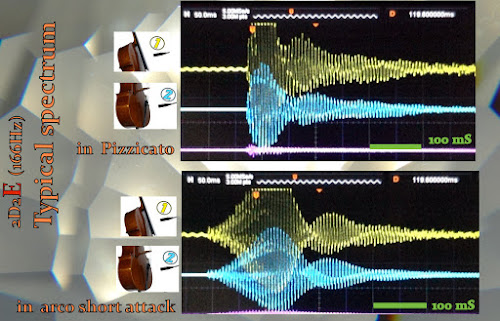[ 09/06/2020 ] Labels: 61..Sound color-2, 63.Wolf tone
Many oscilloscope screenshots hint us a regularity in their resonance spectrum according to the tone name such as C,D,E,F,G,A,, only when they played by pizzicato. Each tone's spectrum shape seems very resembling beyond octaves or cello instruments.
The first two screenshots are typical E(166Hz, second semitone on D string) spectrum of pizzicato and short arco attack. They are all consisted of 6mS(E,166Hz) fundamental vibration and seem as if they are totally twisted or rolling.
The last two screenshots are very unique: E(almost 166Hz, 9th semitone on E string) wolf tone in pizzicato and arco long tone. The amplitude of wave regularly/irregularly dies away and recovers again.
Wolf tones probably relate to the simple/inflexible resonance of top-plate of cello.
オシロスコープで多くのCelloの音波形を見ていると、pizzicatoの波形は オクターブや楽器の違いとあまり関係なく C-D-E-F-G--等の音名ごとで極めてよく似ていることに気づく。例えば、E(166Hz, D線上第2半音)の典型的な波形は、最初の写真のようである。(上:ピチカート、下:短いアルコ・アタック)、6mSの基本周期で規則的に振動しながらねじれている(あるいはローリングしている)かのように見える。
下の写真は、その特殊なケースであるのウルフトーン(G線上の第9番半音付近で観察)をとらえたユニークな写真である。(上:ピチカートの中のウルフトーン、下:アルコの伸ばし音の中のウルフトーン)。途中一端振幅がゼロになっては復活している。
おそらくウルフトーンは表板のシンプルな振動と関連があり、厳格に左右対称に作られた楽器で起こりやすいのだろう。いづれもオシロスコープの水平格子幅は50mS。


